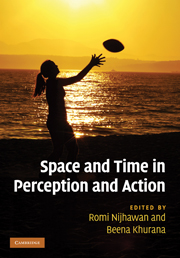Book contents
- Frontmatter
- Contents
- List of contributors
- Acknowledgments
- 1 Space and time: the fabric of thought and reality
- Part I Time–space during action: perisaccadic mislocalization and reaching
- Part II Temporal phenomena: perception
- 10 Saccadic chronostasis and the continuity of subjective temporal experience across eye movements
- 11 Experiencing the future: the influence of self-initiation on temporal perception
- 12 On the perceived interdependence of space and time: evidence for spatial priming in the temporal kappa effect
- Part III Temporal phenomena: binding and asynchrony
- Part IV Spatial phenomena: forward shift effects
- Part V Space–time and awareness
- Index
- References
10 - Saccadic chronostasis and the continuity of subjective temporal experience across eye movements
from Part II - Temporal phenomena: perception
Published online by Cambridge University Press: 05 October 2010
- Frontmatter
- Contents
- List of contributors
- Acknowledgments
- 1 Space and time: the fabric of thought and reality
- Part I Time–space during action: perisaccadic mislocalization and reaching
- Part II Temporal phenomena: perception
- 10 Saccadic chronostasis and the continuity of subjective temporal experience across eye movements
- 11 Experiencing the future: the influence of self-initiation on temporal perception
- 12 On the perceived interdependence of space and time: evidence for spatial priming in the temporal kappa effect
- Part III Temporal phenomena: binding and asynchrony
- Part IV Spatial phenomena: forward shift effects
- Part V Space–time and awareness
- Index
- References
Summary
Summary
The term “saccadic chronostasis” refers to the subjective temporal lengthening of a visual stimulus perceived following a saccadic eye movement. In this chapter, we discuss our preferred account of the illusion, which posits that the onset of the postsaccadic stimulus is antedated to a moment just prior to movement initiation, and review supporting evidence that illustrates key characteristics of the illusion, including its dependency on saccade extent. We conclude with a brief discussion of other examples of biased time perception that have been linked to saccadic chronostasis.
Introduction
When people make a saccadic eye movement to fixate a new visual target, they overestimate the duration for which that target is perceived (Yarrow et al. 2001). This illusion, which we have called saccadic chronostasis, has been demonstrated using the following basic procedure. Subjects make a saccade to a target that changes form or color during the saccade. They judge the duration of the new target stimulus relative to subsequently presented reference stimuli, and these judgments are used to determine a point of subjective equality (PSE; the point at which the target and reference stimuli are perceived to have identical durations). This procedure is schematized in Fig. 10.1. The same task performed while fixating forms a control. Reduced PSEs in saccadic conditions compared to control fixation conditions are a gauge of the temporal overestimation of the postsaccadic stimulus.
- Type
- Chapter
- Information
- Space and Time in Perception and Action , pp. 149 - 163Publisher: Cambridge University PressPrint publication year: 2010
References
- 3
- Cited by



